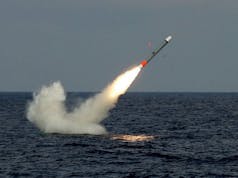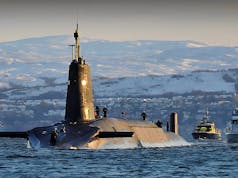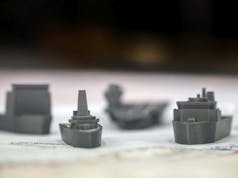Type 45 Destroyer HMS Dragon has successfully shot down a supersonic drone off the coast of Scotland during Exercise Formidable Shield 25.
The drill was part of Europe’s largest live-firing exercise this year and tested HMS Dragon’s advanced air defence capabilities against a challenging high-speed target.
In a dramatic display of firepower, the warship launched a specially-modified Sea Viper missile, which intercepted and destroyed the incoming supersonic target. The missile fired by HMS Dragon was a telemetry version designed to record data and inform future operations.
Commander Iain Giffin, Commanding Officer of HMS Dragon, described the successful missile launch as a significant milestone:
“The successful Sea Viper firing as part of Formidable Shield 25 is a huge moment for HMS Dragon. Not only does it prove that Dragon’s world-leading air defence capability functions as it should following an extensive maintenance period, but it also proves our ability to integrate and operate alongside NATO allies and partners.”
The target, described as a supersonic missile, posed a unique challenge by performing corkscrew and weave manoeuvres at high speeds. Just 2.5 seconds after leaving the ship’s silo, the Sea Viper missile reached Mach 4 – four times the speed of sound – and executed precise, high-G manoeuvres to intercept the drone.
Lieutenant Commander Sarah Kaese, Senior Warfare Officer on HMS Dragon and on exchange from the Royal Australian Navy, praised the ship’s crew for their achievement:
“Formidable Shield has been both a significant challenge and opportunity for Dragon to come together as a warfighting unit and integrate into a task group developing air defence capability.”
Exercise Formidable Shield 25
Exercise Formidable Shield 25 involves ships, aircraft, and land forces from 11 NATO nations, focusing on air and missile defence in a multi-domain environment.
Nearly 7,000 personnel are participating, with missile launches from both naval and land-based platforms. The first phase took place at the Andøya firing range in Norway, before moving to the Hebrides range in Scotland. The exercise will conclude on May 31.
HMS Dragon’s success demonstrates the destroyer’s ability to counter modern threats, including uncrewed systems and advanced missile attacks, as part of the Royal Navy’s continued efforts to enhance its air defence capabilities.














This is exactly why we need these state of the art cutting edge world class ships, who’d have predicted drones with such long range all those years ago ?
“If you want to conquer the world, you best have dragons”.
DRONES ARE JUST DRONES. Hypersonic Missile systems that fly at Mack 12 or above, have rendered these Big WW2 style battleships OBSOLETE relics from the Hollywood era.
Good thing that no navy in the world operated WW2 battleships anymore.
MISSING THE POINT COMPLETELY IS QUITE AN ART. There are only 2 types of marine warship, in the 21st century. Submarines and targets.
Well done for regurgitating a bit of Submarine banter, but that’s also simply not true.
Don’t want to be negative about this but surely there is cheaper ways to down drones by now, I know drones are getting better and might be harder to hit but there must be something else where your not spending a fortune to hit one.
Not sure if there are many supersonic drones in any nations arsenals, but if there are then you would need a sophisticated system like sea-viper to knock them down.
Thanks for that, it just seems a bit nuts to fire missiles that cost a fortune for something that probably doesn’t cost much to put together, I know we’re getting Dragonfire but with the way Ukraine is with drones I really thought we’d be pushing for cheap missiles or cheaper missiles to do the job but if you say the viper is needed for it we just have to go with it, at some point the countries we see as hostile could end up spending more on defence than us with drones and missiles that probably cost less so it could get a bit scared.
Scary
In this scenario, the supersonic target drone is not representing a drone, but a supersonic anti-ship missile. Much like the ones predominantly used by Russia and now China. Qinetiq build the Mach 2+ Rattler and there’s also the GQM-163 Coyote supersonic drone made by Northrop Grumman, that are used in these exercises. Both drones can fly in a sea skimming mode, or following a ballistic path. The Rattler in particular can do terminal high jinking manoeuvres to try and throw off the air defences.
In time I am positive we will see both Dragonfire and Microwave based weapons fitted to ships. However, both of these system must be considered as supplements to CIWS. They will not have an effective range over 10 miles (more likely 10km on a good day), until the technology gets significantly better. Additionally, there needs to be a lot more testing/modelling done on how a microwave weapon counters a traditional anti-ship missile that is predominantly made from aluminium alloy, rather than fibreglass. Which will act as a barrier to RF.
Surfaced launched missile still provide the ship with the highest percentage of achieving a kill on the threat, especially over distance. The Leonardo DART guided round fired from the 76mm cannon. Has shown that it can take out both drones as well as subsonic anti-ship cruise missile, when used by the Italian Navy off the coast of Yemen. Dart is a first generation guided round, which uses command guidance. However both BAe and DARPA/Raytheon have shown that the next 2nd gen guided rounds are a step change in capability. The BAe Hyper Velocity Projectile (HVP) and DARPA’s MAD-FIRES have demonstrated in trials that a single gun can use these rounds to engage multiple targets, as they use semi-active radar homing (SARH). Meaning a ship’s radar just has to illuminate the targets and the round just homes in on the reflection. The HVP in trials has shown that can engage targets 20 miles away. Whilst MAD-FIRES being a smaller 57mm sabot maxes out at around 10 miles. But gets their a lot quicker than DART, as it uses rocket assistance. So it should really be considered a gun launched missile. Both of these system if they go into production, will offer a significantly cheaper means of engaging aerial threats. But they still wont have the range of a dedicated missile such as Aster or SM6.
Thanks for that daveyb appreciate the info.
My impression the DARPA MAD FIRES is dead and USN Oct. 23 is funding Northrup Grumman to develop a new fuze for the 57mm 6 lb shell for the Mk 110 gun.
Think the BAe HVP development is dependent on the US Army obtaining funding for the $646 million 2025-27 MDAC AA programme, requires a very accurate high definition radar to search and track both target and HVP to a centimeter to keep costs down as the HVP will not have a sensor.
The reports have seen on the range of High Power Microwaves may be shorter range than 10 km you quote, the British Army Thales Rapid Destroyer is 1 km, subject to the fourth power law so as distance increases power required rises exponentially.
To answer Nick’s comment below. MAD-FIRES is still alive and kicking. The USN are fitting the Mk110 57mm to the Constellation class frigates. They have stated that along with MAD-FIRES, the gun will also use the Alamo guided shell.
The HVP is a guided projectile. The program was shelved a few years ago (2022) to save money. But due to the Operations in the Red Sea, along with the very high expenditure of surface to air missiles. The USN are funding the project again, as the projectile demonstrated it could hit maneuvering targets out to 20 miles, when fired from the Mk45. What BAe have not stated is what type of seeker it uses. During the development of the electromagnetic gun that HVP was originally designed for. BAe did use some of the systems from the DART guided round they helped develop with Leonardo. I do suspect that the projectile uses command guidance as per DART. But they have said they are developing new guidance systems for the HVP, which could include SARH or IR. I fully expect it to have a multi-ignition fuse, ie impact and proximity. It will also likely get a timed fuse mode, as they have said it can be used against land targets. Using the either of the two new guidance methods, would increase the number of targets that could be engaged in a near simultaneous engagement.
The Mk45 using timed airburst shells was fairly effective at knocking down Houthis drones. It was this and the high number/cost of ESSM, SM2 and SM6 used, that has driven them to look at a cheaper and more plentiful alternative. Especially as an Arleigh Burke can hold 600 shells in its magazine. A lot will depend on the price per round of HVP, which was originally quoted as being less than $100k.
The later Arleigh Burke’s with SPY-6 are more than capable of tracking an incoming target and provide a tracking solution for HVP, using a continuous wave transmission. On the older ships, SPY-1D is probably not up to it, whilst their AN/SPG-2 illuminators should be capable of doing this.
I will not quote the estimated or true range that the Microwave weapon is capable of achieving. Especially for a weapon that will be coming in to service with our military soon. Additionally we do not know what frequency it is transmitting on. But the size of the antenna does hint at this.
It is interesting that you’re quoting the fourth power law for radio transmissions. I’d be interested to know why you feel there should be a fourth power law?
As far as know the USN has never placed a contract with Raytheon for the development or production of the 57mm MAD FIRES, it was funded by DARPA and never made the transition to the USN, but as pointed out the USN did contract Northrup Grumman for a new 57mm, not saying USN might adopt MAD FIRES but at the moment its now funding the NG 57mm
NG
“The 57mm guided high explosive ammunition has the unique ability to continuously maneuver in-flight as it moves toward a designated target. Designed to defend against fast moving surface threats, drones and swarming threats, the guided 57mm ammunition features an on-board seeker to acquire moving targets and a fuze with the ability to self-select for either proximity or point-detonation mode to best engage and defeat the intended target. “Our new 57mm guided ammunition is truly innovative in its ability to identify, track and guide itself to a target,” said Dave Fine, vice president, armament systems, Northrop Grumman. “The Navy will gain a greater capability to defend against moving threats and a new level of accuracy to defeat them.”
As the newest addition to Northrop Grumman’s advanced ammunition portfolio, the 57mm round leverages the company’s expertise in guided munitions, such as the Precision Guidance Kit. Utilizing seekers and an aft-maneuver system, the round provides continuous trajectory guidance no matter how often the target may pivot. This new guided ammunition will give the Navy greater stand-off range and a cost-effective solution against small, fast-moving threats, without any weapon system modifications.”
Re the BAe HVP should note the US Army MDAC AA system that plans to use the HVP, what’s significant is the HVP does not have an onboard seeker. The radar should perform not only search, detection, and precision tracking of incoming threats, but also provide Army hypervelocity projectiles with the ability via datalink to navigate, fuze accurately, and possibly even provide battle damage assessment. This kind of multi-function precision radar technology has the potential to help drive down the costs of air and missile defense munitions by enabling these weapons to operate without expensive onboard seekers and guidance systems and operate at long ranges and in bad weather conditions like heavy rain, snow, wind, and dust (looks like a veiled ref to the short comings of lasers).
Would note the SPY-1 and SPY-6 use S-band whose wavelength is 7.5 to 15 cm much too low for the 1 cm centimetric accuracy required.
Definition of the Inverse Square Law as applies to radar and also to HP Microwaves
The basic principle of electromagnetic wave propagation is that power density decreases with the square of the distance (1/r²) from the source. This means that as a radar signal travels, its power decreases as the square of the distance.
Anything that can reach supersonic speed is not cheap to build
Thanks bof I didn’t realize that it would cost much more for supersonic in drones.
I would suspect the supersonic drone was attempting to be representative of a supersonic missile indeed it suggests that at one point in the story. I can’t comment on how representative it is in practice but supersonic drones are a bit of a area where they become more missile than drone but the test vehicle used may be considered a drone because of its role so all a bit nebulous that’s not worth getting hung up on I think.
Maybe a marineize box launched version of Starstreak missile?
“Not sure if there are many supersonic drones in any nations arsenals”
Of course they are. Even not nations. Hamas, Heezbollah, Houthis have ballistic missiles that are by nature of their flight are supersonic.
I think the clue is in their name ie ‘missiles’. In reality though you are not wrong, where do drones actually end and missiles begin. These are called drones I suspect because of their role in being programmed to represent or mimic a range of threats predominantly missiles in this case but aren’t designed to be a direct threat in themselves.
Only supersonic DRONES I know of are the Lockheed D-21 and Turkey is developing one, neither are widely used anywhere.
What Hamas, Hezzbollah, and the Houthis have are missiles and simpler drones that cruise at subsonic speeds.
Russia (& China?) have these (I’ve heard). They’ve also been playing with hypersonic airware, but to date, that’s been a bit hit or miss (pardon the pun!). Whether that extends to drones or not, I don’t know
Drone is the wrong way of terming this target. It’s not a Iranian/Russian/Ukrainian suicide drone, it’s a large Mach 4-capable target drone intended to mimic a cruise missile.
This was a target drone that was pretending to be a hight speed manoeuvring missile.. not a drone drone if you know what I mean 😀
NL has the same story, but says it was a supersonic missile…
The headline says “Drone” but the text says
“The target, described as a supersonic missile”
Type 45s starting to show their worth 😏
Cost of munitions (and drones aside) I would like to see such an engagement involve 8 or so “vampires” to see if multiple engagement actually works. Shooting down a lone unit isn’t that significant in a swarm style attack.
Sea Viper can control 16 missiles simultaneously (AFAIK), and the A50 can launch missiles at a rate of 1 every 1.25 seconds. Each missile is ARH, which improves counter-swarm capability for the system as a whole.
Sea Viper, remember, was built specifically to counter large volleys of Soviet supersonic, approaching hypersonic, cruise missiles towards the tail end of the Cold War. It has also been tested against swarm attacks.
FS Normandie fired off an Aster 30 too as part of the exercise, it may have been part of a layered response.
They definitely do this in war-games as a simulation. I was reading about one in 2021 where they simulated engaging a dozen+ anti-ship missiles in a single attach on a vessel. In practice it would obviously just be far too expensive but also as mentioned elsewhere if the system can guide numerous missiles, track numerous targets, and has a high rate of fire, speed and range, there’s no reason why it couldn’t be repeating this same engagement many other times simultaneously.
Despite all their problems the type 45s are finally starting to show how formidable they are and why the yanks love them protecting their carriers!
Once sea ceptor is and BMD sorted they will probably be the best air defence ships on the planet.
The tragedy is only 6 of these magnificent ships were built🙄
George, could you amend the title – calling this a ‘drone’ is slightly misleading considering this was in fact a cruise missile target flying at Mach 4 and performing hard evasive manoeuvres.
Now try shooting down a dozen supersonic-antiship missiles coming in from different directions and altitudes, because that’s what China will do in a war.
Use the word “drone” for a fantastic headline.
Supersonic manoeuvring target will never catch the eye.
Ultimately warfare has been about affordability. Major wars have not been won by penny pinching but by all out indusrial effort. If you cant afford the industry you lose the war.